
Musée National du Moyen Age
Map: Cluny Museum—Ground Floor
Rooms 2 and 3: Temporary Exhibits
Room 8: Stone Heads from Notre-Dame
Room 9: Roman Bath and Pillar of the Boatmen
Room 13: The Lady and the Unicorn Tapestries
The National Museum of the Middle Ages doesn’t sound quite so boring as I sink deeper into middle age myself. Aside from the solemn religious art, there’s some surprisingly lively stuff here.
Paris emerged on the world stage in the Middle Ages, the time between ancient Rome and the Renaissance. Europe was awakening from a thousand-year slumber. Trade was booming, people actually owned chairs, and the Renaissance was moving in like a warm front from Italy.
(See “Cluny Museum—Ground Floor” map, here.)
Cost: €8, free on first Sun of the month, covered by Museum Pass.
Hours: Wed-Mon 9:15-17:45, closed Tue.
Getting There: The museum, a five-minute walk from Ile de la Cité, is a block above the intersection of Boulevards St. Germain and St. Michel, at 6 Place Paul Painlevé (Mo: Cluny-La Sorbonne, St. Michel, or Odéon; bus #63 from Rue Cler or #86 from the Marais).
Information: Pick up the free, handy museum map. Tel. 01 53 73 78 16, www.musee-moyenage.fr.
Tours: The helpful audioguide is included with admission, though Museum Pass holders must pay €1 for it.
Length of This Tour: My self-guided tour takes about one hour, but allow browsing time for “The Rest of” the underrated Cluny. With less time, focus on the Roman Bath and the Lady and the Unicorn tapestries. While the medieval enthusiast could spend hours in this museum, in this chapter, I cover only the highlights.
Baggage Check: Required for bags larger than a purse, and free.
Cuisine Art: Just a few blocks away, the charming Place de la Sorbonne has several good cafés (see here; walk up Boulevard St. Michel toward the Panthéon). The peaceful square facing the museum entry has flowers, children playing, and plenty of picnic benches.
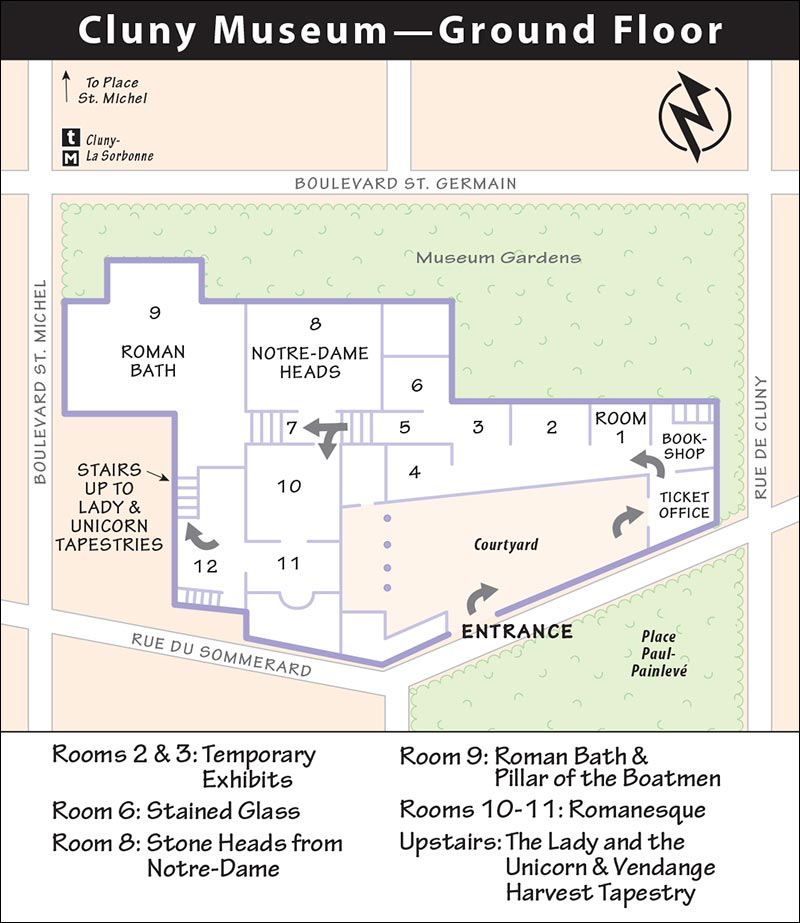
(See “Cluny Museum—Ground Floor” map, here.)
• Our tour begins in Room 6, with medieval stained glass. But take a moment to enjoy the first few rooms, which are usually reserved for temporary exhibits related to the theme of medieval life.
The museum may surprise you with its lack of grim, gray crucifixions and other symbols associated with medieval times. The Cluny feels more like a celebration of life in the Middle Ages. Among the temporary displays you may find joyfully elegant tapestries, golden altarpieces, and statues with a budding realism. Mother Mary is depicted elegantly sway-hipped and smiling. Colorful woven fabrics were brought back to France by Crusaders, who went off to conquer barbarian infidels but returned with tales of enlightened peoples on the fringes of Europe.
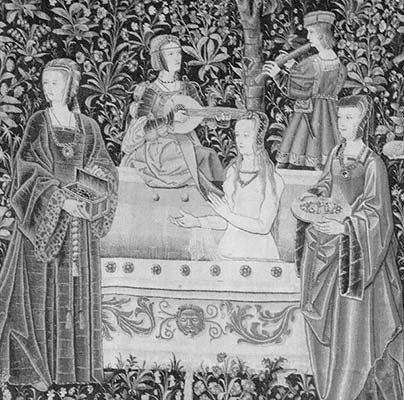
Not every work of art in the later medieval period was centered on religious themes. Having survived their Y1K crisis, these people realized the world wasn’t about to end, and they turned their attention to the beauty of their surroundings.
• After the two rooms of temporary exhibits, you enter a small hall. Turn right into a little, dark room full of luminous stained glass.
Enter the Dark Ages, when life was harsh and brutal, angels and demons made regular appearances, and the Church was your only refuge. This room offers a rare close-up look at stained glass, which gave poor people a glimpse of the glories of heaven. These panels (all 13th- and 14th-century originals, many from the basilica of light, Sainte-Chapelle) give us a window into the magical, supernatural, miraculous—and often violent—medieval mind.
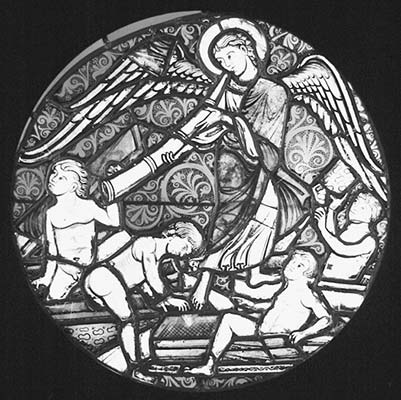
Read clockwise around the room, all at eye level (the bottom): 1) The angel Gabriel blasts his didgeridoo on Resurrection morning, rousting the grateful dead from their coffins. Notice that Gabriel’s royal robe is made up of several different pieces of glass—purples, whites, blues—held together with lead. 2) Naked Christ is baptized in the squiggly River Jordan. 3) A red-faced, horned, horny demon, accompanied by an equally lascivious wolf and henchman, carries off a frightened girl in red on a date from hell. 4) Blond, pious boy Joseph is sold into slavery to camel merchants by his plotting brothers.
Next wall: 5) Samson is about to pull down the temple... 6) Then he has his eyes gouged out by Philistines. 7) Slaughter on the battlefield. Men with bloodstained hands and faces hack at each other with golden swords. 8) Aaron, disobeying God and Moses, worships a golden calf. 9) A king on a throne closes his eyes to all this wickedness.
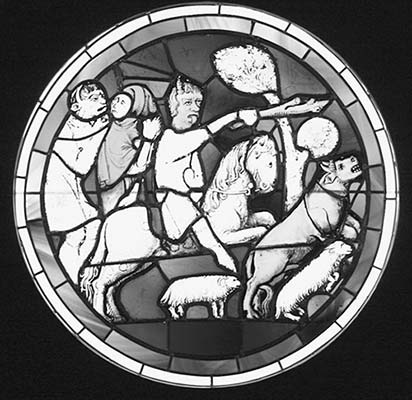
Next wall (with some panels from the first Gothic church, St. Denis): 10) Two monks with prayer books gaze up, as one of their brothers disappears into heaven. The Latin inscription “hec est via” means “This is the way.” 11) Seated Jesus, in a royal purple robe, is consoled by two angels. 12) Theophilus (“Lover of God”) has struck a Faustian deal—shaking hands with the red-faced devil, yet feeling buyer’s remorse. 13) Sleeping St. Martin is visited by a heavenly vision. 14) Angels in Rock-and-Roll Heaven.
Last wall: Four apostles—John (Ioannes), James (with his scallop shell), Paul, and Peter (Petrus, with key).
• Before leaving, open the display cover under the Angel Gabriel and run your fingers along the glass and lead to get a feel for the thickness of each. Now, turn around and take in all the narrative medieval glass.
This room has occasional exhibits, as well as the permanent displays, so be prepared to search for the objects described.
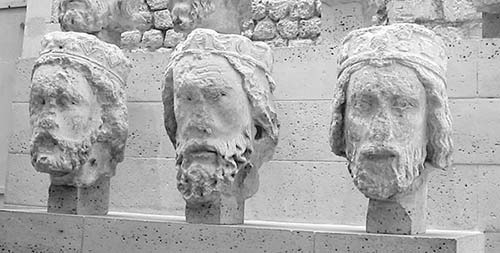
The 21 stone heads (sculpted 1220-1230) of the biblical kings of Judah once decorated the front of Notre-Dame. In 1793, an angry mob of Revolutionaries mistook the kings of Judah for the kings of France and abused and decapitated the statues. (Today’s heads on the Notre-Dame statues are reconstructions.) Someone gathered up the heads and buried them in his backyard near the present-day Opéra Garnier. There they slept for two centuries, unknown and noseless, until 1977, when some diggers accidentally unearthed them and brought them to an astounded world. Their stoic expressions accept what fate, time, and liberals have done to them.
The statue of Adam (nearby) is also from Notre-Dame. He’s scrawny and flaccid by Renaissance standards. And it will be another 200 years before naked Adam can step out from behind that bush.
This echoing cavern was a Roman frigidarium. Pretty cool. The museum is located on the site of a Roman bathhouse, which was in the center of town during the Roman years. The sunken area you see in the alcove was exactly what it looks like: a swimming pool. After hot baths and exercise in adjoining rooms, ordinary Romans would take a cold dip there, then relax cheek to cheek with such notables as Emperor Julian the Apostate (see his statue), who lived next door. As the empire decayed in the fourth century, Julian avoided the corrupt city of Rome and made Paris a northern power base.
The 40-foot-high ceiling is the largest surviving Roman vault in France, and it took the French another 1,000 years to improve on that crisscross-arch technology. The sheer size of this room—constructed in A.D. 200, when Rome was at its peak—gives an idea of the epic scale on which the Romans built. It inspired Europeans to greatness during the less civilized Middle Ages.
Next to the pool find four stone pillars, each holding a square fragment of the Pillar of the Boatmen (Le Pilier des Nautes), which decorated the ancient Roman temple that stood where Notre-Dame stands today. These fragments, probably the oldest man-made objects you’ll see from Paris, once fit together to help support a 20-foot-high altar to the king of the gods in the Temple of Jupiter. Take a close look at three of these (starting with the pillar closest to the pool and working counterclockwise):
1) The fragment labeled Pierre de la dédicace is inscribed “TIB. CAESARE,” announcing that the altar was built under Emperor Tiberius (A.D. 14-37, who reigned during the time of Jesus Christ) and was paid for by the Parisian boatmen’s union (see them holding their shields).
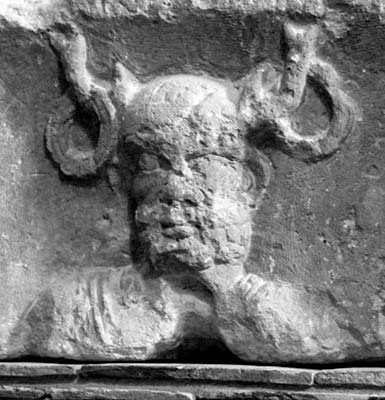
2) On the pillar labeled Pierre aux quatre divinités, find the horned Celtic god Cernunnos, who is also known as the Stag Lord and god of the hunt. The eclectic Romans allowed this local “druid” god to support the shrine of Jupiter, in league with their own Vulcan, who hammers, and Castor and Pollux, who pet their horses.
3) On the tallest pillar, the fragment labeled Bloc dit “de Jupiter” shows Jupiter in his royal robes leaning on a spear, as well as the god Vulcan hammering in his fiery forge.
Rome lived on after the fall of the empire, in the “Roman”-esque grandeur of Christian churches.
Browse these rooms, seeing how artists used Roman style and techniques to create religious art: statues of a smiling, gracefully posed Mary, decorative flourishes from church buildings, and exquisitely carved mini altarpieces in ivory (in the glass cases). The box, finely carved from an elephant tusk, in the glass case in Room 11 provides an exquisite look at life during the age of courtly love (circa 1300).
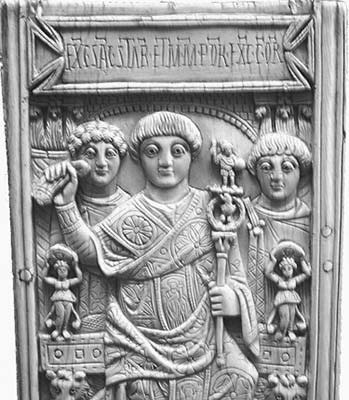
• Continue upstairs to...
As Europeans emerged from the Dark Ages, they rediscovered the beauty of the world around them.
These six mysterious tapestries were designed by an unknown (but probably French) artist before 1500 and were woven in Belgium out of wool and silk. Loaded with symbols—some serious, some playful—they have been interpreted in many ways, but, in short, the series deals with each of the five senses (find more detail by picking up the handheld explanations from slots hanging on the wall).
In medieval lore, unicorns were enigmatic, solitary creatures, so wild that only virgins could entice and tame them. In secular society, they symbolized how a feral man was drawn to his lady love. Religiously, the unicorn was a symbol of Christ—radiant, pure, and somewhat remote—who is made accessible to humankind by the Virgin Mary. These tapestries likely draw inspiration from all these traditions.

• Moving clockwise around the room...
Touch: This is the most basic and dangerous of the senses. The scene is set in the wild: monkeys, a leopard, and exotic birds. A blond lady “strokes the unicorn’s horn”—if you know what I mean—and the lion gets the double entendre. Medieval Europeans were exploring the wonders of love and the pleasures of sex.
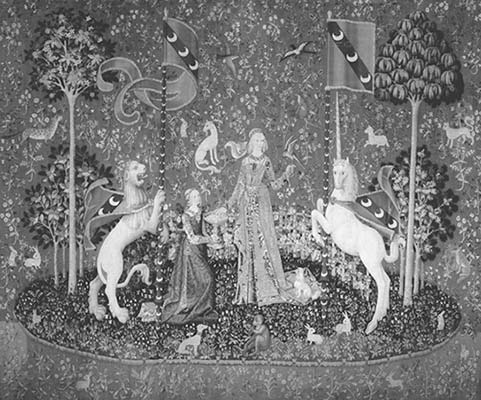
Taste: The lady takes candy from a servant’s dish to feed it to her parakeet. A unicorn—a species extinct since the Age of Reason—and a lion look on. At the lady’s feet, a monkey also tastes something, while the little white dog behind her wishes he had some. This was the dawn of the Age of Discovery, when overseas explorers spiced up Europe’s bland gruel with new fruits, herbs, and spices.
The lion (symbol of knighthood?) and unicorn (symbol of “bourgeois nobility,” purity, or fertility?) wave flags with the coat of arms of the family that commissioned the tapestries—three silver crescents in a band of blue.
Smell: The lady picks flowers and weaves them into a sweet-smelling wreath. On a bench behind, the monkey apes her. The flowers, trees, and animals are exotic and varied. Each detail is exquisite alone, but if you step back they blend together into pleasing patterns.
Hearing: Wearing a stunning dress, the lady plays sweet music on an organ, which soothes the savage beasts around her. The pattern and folds of the tablecloth are lovely. Humans and their fellow creatures (cats, dogs, and rabbits) live in harmony in an enchanted blue garden filled with flowers, all set in a red background.
Sight: The unicorn cuddles up and looks at himself in the lady’s mirror, pleased with what he sees. The lion turns away and snickers. As the Renaissance dawns, vanity is a less-than-deadly sin.
Admire the great artistic skill in some of the detail work, such as the necklace and the patterns in the lady’s dress. This tapestry had quality control in all its stages: the drawing of the scene, its enlargement and transfer to a cartoon, and the weaving. Still, the design itself is crude by Renaissance 3-D standards. The fox and rabbits, supposedly in the distance, simply float overhead, as big as the animals at the lady’s feet.
Tapestry #6: The most talked-about tapestry gets its name from the words on our lady’s tent: A Mon Seul Désir (To My Sole Desire). What is her only desire? Is it jewelry, as she grabs a necklace from the jewel box? Or is she putting the necklace away and renouncing material things in order to follow her only desire?
Our lady has tried all things sensual and is now prepared to follow the one true impulse. Is it God? Love? Her friends the unicorn and lion open the tent doors. Flickering flames cover the tent. Perhaps she’s stepping out from the tent. Or is she going in to meet the object of her desire? Human sensuality is awakening, an old dark age is ending, and the Renaissance is emerging.
From the unicorn tapestries, explore the rest of this fine museum’s upper rooms to view medallions, more tapestries, medieval altarpieces, old books, swords and guns, and much more. The audioguide lets you key in on more exhibits.
In Room 19, pay your respects to the tusk of a narwhal (in a tall glass case in the corner), which must have convinced superstitious folk to believe in unicorns. In the Middle Ages, narwhal tusks were sold as unicorn relics.
In Room 22, the large Vendange Harvest Tapestry shows events during the vendange, the annual autumn harvest and wine celebration. A peasant man treads grapes in a vat while his wife collects the juice. A wealthy man gives orders. Above that, a peasant with a big wart turns a newfangled mechanical press. On the right, you’ll see the joy of picking—pawns, knights, and queens all working side by side. Ah, the simple joys of the Middle Ages.
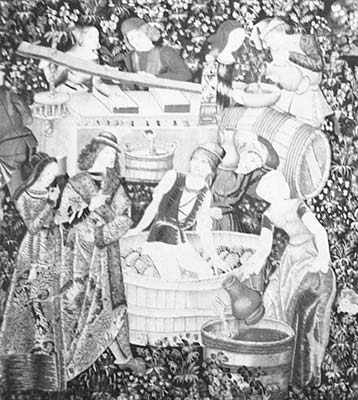
• When you’re ready, leave the Middle Ages and return to your modern, fast-paced life...